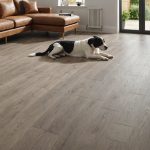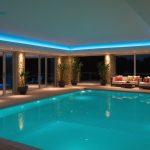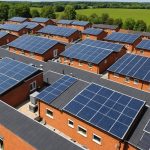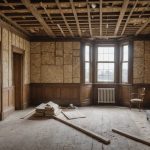Understanding the Importance of Insulation for Victorian Homes
Victorian homes, with their historical charm, often face challenges when it comes to energy efficiency. The key to maintaining these homes lies in balancing modern insulation benefits with the preservation of their architectural integrity.
Many Victorian homes suffer from common insulation issues such as draughty windows and inadequate wall insulation, contributing to higher heating costs. Addressing these can markedly enhance the property’s energy efficiency. An optimised insulation approach not only reduces utility bills but also creates a more comfortable living environment.
Also to read : Enhance your building's aesthetics with expert fencing and cladding
Preserving the aesthetic and structural elements of these treasured homes is crucial. Modern insulation solutions, like using breathable materials, ensure that the historical aspects remain intact while significantly boosting energy efficiency. Furthermore, carefully retrofitting insulation reduces environmental impact and upholds the home’s original character.
When considering insulation improvements, focus on problem areas such as the roof, floors, and gaps around windows. These updates can lead to immediate benefits in heating management without compromising on the home’s historic charm. By adopting this approach, homeowners can look forward to a sustainable future while honouring their Victorian heritage.
In the same genre : Maximizing Solar Efficiency: The Best Panel Arrangement for Terraced Roofs in Reading
Types of Budget-Friendly Insulation Solutions
Energy efficiency is key when considering cost-effective insulation materials. In this section, we explore various types of insulation that provide excellent energy-saving solutions.
Fiberglass Insulation
Fiberglass insulation is one of the most popular types of insulation due to its affordability and effectiveness. Made from fine glass fibres, it is commonly available in batts and rolls, which makes it easy to install. This cost-effective insulation material offers good thermal resistance, helping to maintain consistent indoor temperatures and lower energy costs. In terms of suitability, fiberglass is ideal for Victorian structures, especially when retrofitting, as it can fit snugly in existing wall cavities without major alterations. While generally budget-friendly, additional vapor barriers may be needed to prevent moisture issues.
Spray Foam Insulation
Spray foam insulation provides impressive air sealing and is known for its excellent energy-saving capabilities. Applied as liquid, it expands to fill every nook and cranny. This adaptability makes it valuable for complex structures but can be challenging to apply without skilled professionals. Its initial cost can be higher compared to fiberglass, but it offers greater energy efficiency and lifespan. Environmentally, the use of low-emission formulas is encouraged to minimize any negative impact.
Mineral Wool Insulation
Mineral wool, produced from natural stone and recycled materials, excels in fire resistance and soundproofing. It can be installed in hard-to-reach spaces due to its flexibility. Although more expensive than fiberglass, its long-term durability and performance make it an attractive compromise for those seeking robust energy-saving solutions.
Case Studies of Successfully Insulated Victorian Homes
Transforming a Victorian home into an energy-efficient haven through insulation can be a rewarding venture. Victorian home renovation projects often showcase remarkable energy savings, attributed to innovative strategies and meticulous planning.
In various insulation case studies, reported energy savings range from 20% to an impressive 50%, illustrating the substantial impact of effective insulation. These projects frequently encounter challenges such as preserving historical features while integrating modern energy solutions. Owners tactfully balance this by using materials like aerogel, which offers excellent thermal properties without compromising architectural integrity.
One compelling example involves a Victorian home in Cambridge. By insulating the loft and walls while replacing single-glazed windows with double glazing, the homeowner achieved a significant reduction in heat loss. It exemplifies how such renovations can unlock energy efficiency.
Lessons learned emphasize the importance of a thorough understanding of the building’s characteristics and the use of appropriate insulation materials. Best practices suggest consulting with experts familiar with Victorian home renovation and employing a whole-house approach for optimal results. These case studies provide a valuable blueprint for homeowners looking to enhance both the energy efficiency and comfort of their cherished Victorian residences.
Tips for Installing Insulation in Victorian Homes
Installing insulation in a Victorian home requires special attention due to the architectural nuances and historical significance of these structures. It’s an opportunity to improve energy efficiency while respecting the building’s integrity.
Preparing Your Victorian Home for Insulation
Before commencing your insulation project, there are crucial steps to consider to ensure success. Assess the property’s current condition, identifying any areas needing repairs, such as cracks or dampness, which should be addressed prior to installation. Remember that historical architecture may require specific materials or techniques to maintain its character. Checking for any necessary building permits and understanding local regulations is also essential; this ensures that your project complies with legal and conservation standards.
DIY vs. Professional Installation
Choosing between a DIY approach and seeking professional help depends on your expertise and the project’s complexity. DIY methods offer cost savings but require careful planning, while professional installers bring in-depth knowledge and experience, assuring precision. Evaluating the pros and cons and considering a qualified installer will impact your budget and the overall success of your insulation undertaking.
Maintenance of Insulation
Ongoing maintenance is crucial for optimal performance. Regularly inspecting your home’s insulation can highlight common issues, such as settling or moisture infiltration. Adhering to best practices, like sealing gaps and ensuring adequate ventilation, will help maintain efficiency. Be vigilant for indicators that your insulation needs attention, such as unusual temperature fluctuations.
Cost Comparisons and Energy Bill Savings
When considering insulation cost comparison, it’s crucial to weigh how various types can impact your wallet. Fibreglass insulation, often the most affordable option, ranges from £0.85 to £1.20 per square foot. Spray foam, though pricier at £1.25 to £2.50 per square foot, offers superior coverage. Beyond the upfront investment, your choice can significantly influence energy bill savings.
Different insulation solutions promise varying degrees of savings. Fibreglass typically reduces energy bills by up to 30%, while spray foam can cut costs by as much as 50% due to its air-sealing capabilities. These reductions translate directly into your monthly expenses, offering tangible financial relief.
The home insulation ROI is a key factor for homeowners to consider. Fibreglass often boasts a return of approximately 3-4 years. Conversely, spray foam might take 5-6 years to recoup its costs, but it offers long-term savings that sustain for over two decades.
To maximise return on investment, an understanding of installation expense versus potential savings is essential. Depending on your budget and energy needs, the choice of insulation can influence both immediate and long-term financial health.
Local Regulations and Incentives for Insulation
Navigating the insulation regulations in London, particularly for historical homes, requires an understanding of both local conservation standards and available incentives. Properties with historical significance need to comply with specific guidelines to maintain architectural integrity while improving energy efficiency. This means being aware of the rules that govern changes to protected structures.
London offers grants for insulation to encourage homeowners to improve their property’s energy performance. These grants are designed to offset the costs involved in retrofitting, making it more accessible for all. Such financial support is crucial for homeowners as it helps bridge the gap between conservation needs and the desire for modern energy solutions.
Moreover, energy efficiency subsidies play a significant role in helping residents meet these regulations. Subsidies can reduce the financial impact of implementing compliant insulation measures. Compliance not only ensures you meet legal requirements but also enhances property value and reduces energy bills, reinforcing the sustainable living objective of many London communities.
Understanding these incentives and adhering to conservation standards effectively balances heritage preservation with the benefits of modern insulation. This approach not only satisfies regulatory demands but is also a pragmatic choice for homeowners committed to a sustainable future.
Recommended Products for Victorian Home Insulation
In the quest for enhancing the insulation of Victorian homes, selecting the right products is paramount. Understanding the nuances of these period structures is crucial for optimal results.
Review of Top Insulation Products
Victorian architecture requires insulation that respects its historical aspects while offering contemporary efficiency. Expert insulation solutions are pivotal, ensuring both preservation and performance.
- [Product A]: Lauded for its adaptability, Product A excels in maintaining thermal integrity without compromising historical aesthetics. Its expert insights reveal a high performance in usability with challenging corners often found in Victorian homes.
- [Product B]: Known for its eco-friendly nature, Product B combines sustainability with effective insulation properties. Case studies demonstrate its success in reducing energy consumption while respecting the architectural beauty.
- [Product C]: Boasting top ratings in performance, Product C stands out in user reviews for ease of installation and long-term durability.
Where to Purchase Insulation Materials
When seeking insulation materials tailored for Victorian homes, consider local suppliers in London, who often provide customised options that align with architectural needs. Online resources, such as specialist retailers, offer competitive pricing on budget-friendly materials, making it simpler to stay within financial limits. Furthermore, options for environmentally-conscious consumers are plentiful, providing sustainable insulation products that marry efficiency with responsibility.
Opting for the right recommended insulation products ensures Victorian homes are equipped for modern living while cherishing their historical integrity.











